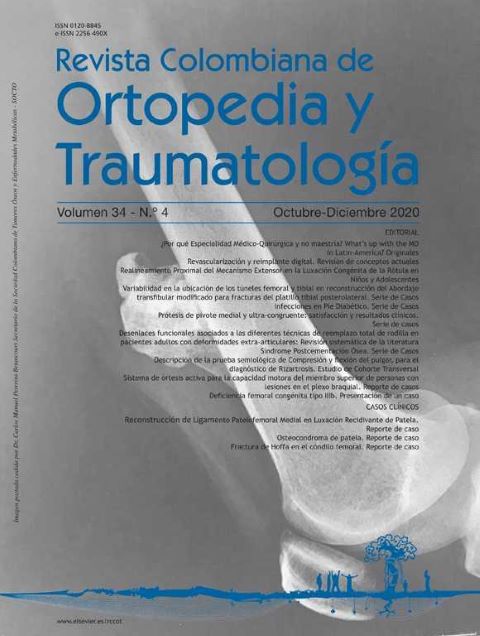Variabilidad en la ubicación de los túneles femoral y tibial en reconstrucción del ligamento cruzado anterior. Revisión narrativa
DOI:
https://doi.org/10.1016/j.rccot.2020.09.004Palabras clave:
ligamento cruzado anterior, reconstrucción del ligamento cruzado anterior, LCA o ligamento cruzado anterior, tibial o femoral y localización de los túneles o posicionamiento o precisión, variabilidadResumen
Introducción: Aunque los estudios detallan el origen, la forma y la inserción del ligamento cruzado anterior (LCA), no hay consenso sobre la ubicación del punto adecuado para el posicionamiento del túnel femoral y tibial en la econstrucción. El objetivo del estudio es revisar la literatura sobre la variabilidad en el posicionamiento de los túneles femoral y tibial en la reconstrucción del LCA.
Materiales y Métodos: Se realizó una búsqueda sistemática y revisión narrativa de la literatura publicada en las bases Medline, Embase, Central, Cochrane y Lilacs, usando términos MesH y libres. Se realizó una selección por título y resumen y revisión de textos completos. Se clasificaron las publicaciones por temas y se hizo una presentación narrativa de los hallazgos.
Resultados: Se incluyeron 25 estudios. Se encontró variabilidad en la selección de áreas de origen e inserción del LCA, tanto en modelos cadavéricos como pacientes: entre los reparos anatómicos para el posicionamiento deltúnel femoral están la cresta intercondilea, cresta bifurcada, cresta del residente, ubicación según el sentido de las manecillas del reloj, remanente del LCA y para el túnel tibial el cuerno anterior del menisco lateral. También hubo variabilidad en los métodos intraquirúrgicos y ayudas imagenológicas como lo son el uso del portal artroscópico antero-medial, cuadrantes de Bernard, fluoroscopio y fluoroscopio navegado. Solo un estudio evaluó la variabilidad en el posicionamiento entre y dentro de cada cirujano mostrando relativa consistencia entre ellos.
Discusión: El sitio de posicionamiento del túnel femoral y tibial para la reconstrucción del LCA, queda determinado por la experiencia del cirujano al no tener guías objetivamente estandarizadas, para realizar la reconstrucción.
Nivel de Evidencia: IV
Descargas
Referencias bibliográficas
Siebold R, Fu FH. Assessment and Augmentation of Symptomatic Anteromedial or Posterolateral Bundle Tears of the Anterior Cruciate Ligament. Arthroscopy. 2008;24: 1289-98. https://doi.org/10.1016/j.arthro.2008.06.016
Piefer JW, Pflugner TR, Hwang MD, Lubowitz JH. Anterior cruciate ligament femoral footprint anatomy: systematic review of the 21st century literature. Arthroscopy. 2012;28:872-81. Epub 2012/02/04. https://doi.org/10.1016/j.arthro.2011.11.026
Wolf BR, Ramme AJ, Wright RW, Brophy RH, McCarty EC, Vidal AR, et al. Variability in ACL tunnel placement: observational clinical study of surgeon ACL tunnel variability. Am J Sports Med. 2013;41:1265-73. https://doi.org/10.1177/0363546513483271
Shafizadeh S, Balke M, Hagn U, Hoeher J, Banerjee M. Variability of tunnel positioning in ACL reconstruction. Arch Orthop Trauma Surg. 2014;134:1429-36. https://doi.org/10.1007/s00402-014-2039-z
Bird JH, Carmont MR, Dhillon M, Smith N, Brown C, Thompson P, et al. Validation of a new technique to determine midbundle femoral tunnel position in anterior cruciate ligament reconstruction using 3-dimensional computed tomography analysis. Arthroscopy. 2011;27:1259-67. Epub 2011/07/12. https://doi.org/10.1016/j.arthro.2011.03.077
Trentacosta N, Fillar AL, Liefeld CP, Hossack MD, Levy M. Avoiding complications and technical variability during arthroscopically assisted transtibial ACL reconstructions by using a C-arm with image intensifier. Orthop J Sports Med. 2014;2, 2325967114530075. https://doi.org/10.1177/2325967114530075
Tampere T, Van Hoof T, Cromheecke M, Van der Bracht H, Chahla J, Verdonk P, et al. The anterior cruciate ligament: a study on its bony and soft tissue anatomy using novel 3D CT technology. Knee Surg Sports Traumatol Arthrosc. 2017;25: 236-44. https://doi.org/10.1007/s00167-016-4310-z
Sven S, Maurice B, Hoeher J, Marc B. Variability of tunnel positioning in fluoroscopic-assisted ACL reconstruction. Knee Surg Sports Traumatol Arthrosc. 2015;23:2269-77. https://doi.org/10.1007/s00167-014-3029-y
Xu H, Zhang C, Zhang Q, Du T, Ding M, Wang Y, et al. A Systematic Review of Anterior Cruciate Ligament Femoral Footprint Location Evaluated by Quadrant Method for Single-Bundle and Double-Bundle Anatomic Reconstruction. Arthroscopy. 2016;32:1724-34. Epub 2016/05/04. https://doi.org/10.1016/j.arthro.2016.01.065
Matava MJ, Arciero RA, Baumgarten KM, Carey JL, DeBerardino TM, Hame SL, et al. Multirater agreement of the causes of anterior cruciate ligament reconstruction failure: a radiographic and video analysis of the MARS cohort. Am J Sports Med. 2015;43:310-9. https://doi.org/10.1177/0363546514560880
Tsuda E, Ishibashi Y, Fukuda A, Yamamoto Y, Tsukada H, Ono S. Tunnel position and relationship to postoperative knee laxity after double-bundle anterior cruciate ligament reconstruction with a transtibial technique. Am J Sports Med. 2010;38:698-706. https://doi.org/10.1177/0363546509351561
Sadoghi P, Kropfl A, Jansson V, Muller PE, Pietschmann MF, Fischmeister MF. Impact of tibial and femoral tunnel position on clinical results after anterior cruciate ligament reconstruction. Arthroscopy. 2011;27:355-64. Epub 2010/12/15. https://doi.org/10.1016/j.arthro.2010.08.015
Wolf BR, Ramme AJ, Wright RW, Brophy RH, McCarty EC, Vidal AR, et al. Variability in ACL tunnel placement: observational clinical study of surgeon ACL tunnel variability. Am J Sports Med. 2013;41:1265-73. https://doi.org/10.1177/0363546513483271
Ferretti M, Levicoff EA, Macpherson TA, Moreland MS, Cohen M, Fu FH. The fetal anterior cruciate ligament: an anatomic and histologic study. Arthroscopy. 2007;23:278-83. Epub 2007/03/14. https://doi.org/10.1016/j.arthro.2006.11.006
Jepsen CF, Lundberg-Jensen AK, Faunoe P. Does the position of the femoral tunnel affect the laxity or clinical outcome of the anterior cruciate ligament-reconstructed knee? A clinical, prospective, randomized, double-blind study. Arthroscopy. 2007;23:1326-33. Epub 2007/12/08. https://doi.org/10.1016/j.arthro.2006.11.006
Smigielski R, Zdanowicz U, Drwiega M, Ciszek B, CiszkowskaLyson B, Siebold R. Ribbon like appearance of the midsubstance fibres of the anterior cruciate ligament close to its femoral insertion site: a cadaveric study including 111 knees. Knee Surg Sports Traumatol Arthrosc. 2015;23:3143-50. Epub 2014/06/29. https://doi.org/10.1007/s00167-014-3146-7
Swami VG, Cheng-Baron J, Hui C, Thompson R, Jaremko JL. Reliability of estimates of ACL attachment locations in 3- dimensional knee reconstruction based on routine clinical MRI in pediatric patients. Am J Sports Med. 2013;41:1319-29. Epub 2013/04/12. https://doi.org/10.1177/0363546513482298
Kato Y, Ingham SJ, Maeyama A, Lertwanich P, Wang JH, Mifune Y, et al. Biomechanics of the human triple-bundle anterior cruciate ligament. Arthroscopy. 2012;28:247-54. Epub 2011/10/25. https://doi.org/10.1016/j.arthro.2011.07.019
Ferretti M, Ekdahl M, Shen W, Fu FH. Osseous landmarks of the femoral attachment of the anterior cruciate ligament: an anatomic study. Arthroscopy. 2007;23: 1218-25. https://doi.org/10.1016/j.arthro.2007.09.008
Kassam AM, Tillotson L, Schranz PJ, Mandalia VI. The Lateral Meniscus as a Guide to Anatomical Tibial Tunnel Placement During Anterior Cruciate Ligament Reconstruction. The open orthopaedics journal. 2015;9(101480491): 542-7. https://doi.org/10.2174/1874325001509010542
Sim J-A, Kim J-M, Lee S, Bae J-Y, Seon J-K. Comparison of tunnel variability between trans-portal and outside-in techniques in ACL reconstruction. Knee Surg Sports Traumatol Arthrosc. 2017;25:1227-33. https://doi.org/10.1007/s00167-015-3950-8
Kim DH, Lim WB, Cho SW, Lim CW, Jo S. Reliability of 3- Dimensional Computed Tomography for Application of the Bernard Quadrant Method in Femoral Tunnel Position Evaluation After Anatomic Anterior Cruciate Ligament Reconstruction. Arthroscopy. 2016;32:1660-6. https://doi.org/10.1016/j.arthro.2016.01.043
Bernard M, Hertel P, Hornung H, Cierpinski T. Femoral insertion of the ACL Radiographic quadrant method. Am J Knee Surg. 1997;10:14-21.
Moloney G, Araujo P, Rabuck S, Carey R, Rincon G, Zhang X, et al. Use of a fluoroscopic overlay to assist arthroscopic anterior cruciate ligament reconstruction. Am J Sports Med. 2013;41:1794-800. Epub 2013/06/08. https://doi.org/10.1177/0363546513490657
Colombet P, Robinson J, Christel P, Franceschi JP, Djian P, Bellier G, et al. Morphology of anterior cruciate ligament attachments for anatomic reconstruction: a cadaveric dissection and radiographic study. Arthroscopy. 2006;22:984-92. Epub 2006/09/06. https://doi.org/10.1016/j.arthro.2006.04.102
Chouteau J, Benareau I, Testa R, Fessy MH, Lerat JL, Moyen B. Comparative study of knee anterior cruciate ligament reconstruction with or without fluoroscopic assistance: a prospective study of 73 cases. Arch Orthop Trauma Surg. 2008;128:945-50. Epub 2007/09/18. https://doi.org/10.1007/s00402-007-0452-2
Shafizadeh S, Jaecker V, Otchwemah R, Banerjee M, Naendrup JH. Current status of ACL reconstruction in Germany. Arch Orthop Trauma Surg. 2016;136:593-603. https://doi.org/10.1007/s00402-016-2426-8
Plaweski S, Cazal J, Rosell P, Merloz P. Anterior cruciate ligament reconstruction using navigation: a comparative study on 60 patients. Am J Sports Med. 2006;34:542-52. https://doi.org/10.1177/0363546505281799









